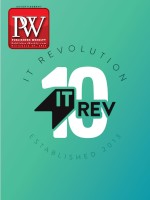Questions surrounding the future of book printing drew a capacity crowd of 155 publishing professionals to the BMI (Book Manufacturers Institute) Book Manufacturing Mastered conference, held September 14 at Penguin Random House’s New York City headquarters. And though the book manufacturing sector was booming during the pandemic, economic conditions have softened and costs for most materials are continuing to go up. Still, speakers at the conference said book printers are generally in a good place, albeit with a host of challenges ahead of them.
In addition to rising costs, topics discussed at the daylong conference included the renewed postpandemic threat of work moving off-shore, sustainability concerns, the shift from offset to digital printing, and labor shortages.
“We’re basically where we were back in 2014,” said Marco Boer, v-p of IT Strategies, in the opening presentation. “We haven’t lost all that printed book volume that people were worried about when e-books came in, and so we all say this is okay. People are continuing to read and print, and that’s great.”
But a deeper look at the numbers and trends reveals some challenges to be addressed, Boer continued, noting that, after some strong years during the pandemic, the printing market is not stable. “Yes, we’ve had a great 2022. But it’s getting a little bit more complicated as we go forward.” He pointed to logistical challenges, uncertainty over how Amazon will impact the market, and rising paper costs, citing a projected annual 3% decline in supply.
In addition, Boer pointed to another key factor that portends change: the end of the megabestseller. He attributed that trend in part to increased competition from other sources of entertainment, pointing out that the Harry Potter series (whose final volume was published in 2007) were the last to sell tens of millions of copies. “Last year, the bestselling titles were by Colleen Hoover, and she sold 2.75 million books.”
Still, Boer said that unit sales in 2022 were stronger than they were in 2019. “So again, things are not bad,” he noted. “But [the instability] means you have to get more efficient.”
On two follow-up panels—one featuring printers and the other publishers—speakers noted that pressure from publishers and consumers for printers to become more environmentally responsible will also add to pricing pressures. For one thing, they said, the cost for postconsumer wastepaper needed for making recycled paper is the highest it’s been in years. But the printers agreed that the book manufacturing sector needs to invest in an environmentally sustainable future. Todd Roth of Thomas Reuters’s core publishing solutions business (which prints about 30 million books per year) said his company’s goal is to reduce its carbon footprint by 50% by 2030. Linnea Knollmueller of Penguin Random House said her company has pledged to be carbon neutral by 2030 and continues to up its use of certified paper (as of 2021, 96% of PRH’s paper came from certified mills).
Roth was one of several panelists who agreed that labor costs for book manufacturers will continue to rise, noting that his company is paying premiums for people to work on second and third shifts as a way to try to attract new talent. The company is also using younger employees to recruit much-needed workers.
While the consensus from the printers’ panel was that prices will have to rise as costs do, the panelists were cognizant that too many increases would negate some of the gains achieved during the pandemic in bringing back work from overseas, particularly from printers in China. David Hetherington of Business International said printers need to work together to convince publishers to support domestic book manufacturing.
A member of the audience noted that it isn’t just rising printer costs that are making publishers reconsider moving manufacturing out of the U.S.—higher trucking costs combined with much lower shipping costs from overseas is another factor.
Speakers on both panels agreed that one effort to control costs that has gained traction among printers and publishers is limiting the number of paper types and sizes used. Ken Miller of specialty paper manufacturer Pixelle said it is now offering about seven standard products, noting that educational publishers in particular have been amenable to the idea of more standardization.
Publishers and printers have also been working to better predict first printings to control costs. There is a growing appreciation of the “total cost of ownership”—i.e., the cost of printing and of storing excess inventory. The best way to keep costs down, said Roger Naggar of Macmillan Learning, is better communication between publishers and printers in order to “get as close as to possible to the perfect order.” He added that “there’s nothing more wasteful than pulping books.”
Other panelists spoke to a similar theme, acknowledging there is merit in debating whether or not it makes financial sense to chase every sale at the cost of overprinting. There was also agreement that forecasting print runs is very difficult. One way to improve forecasting is to move more printing to digital inkjet printers, which bring books to market more quickly while also having the ability to do smaller print runs. With e-books outselling print for Rutgers University Press, Jennifer Blanc-Tal, a production and art director there, said she is always looking for printers that can do quality short-run printings.
Boer of IT Strategies, which works with digital printers, estimated that inkjet technology accounted for 19% of all book pages printed in 2020, rising to 25% in 2022. By 2028, Boer predicted that inkjet will account for 39% of all pages. But even as inkjet printers take market share from offset printers, offset will still account for the most printed pages for many years to come. “Offset is not dead,” Boer said.



 Volume 270
Issue 39
09/25/2023
Volume 270
Issue 39
09/25/2023





